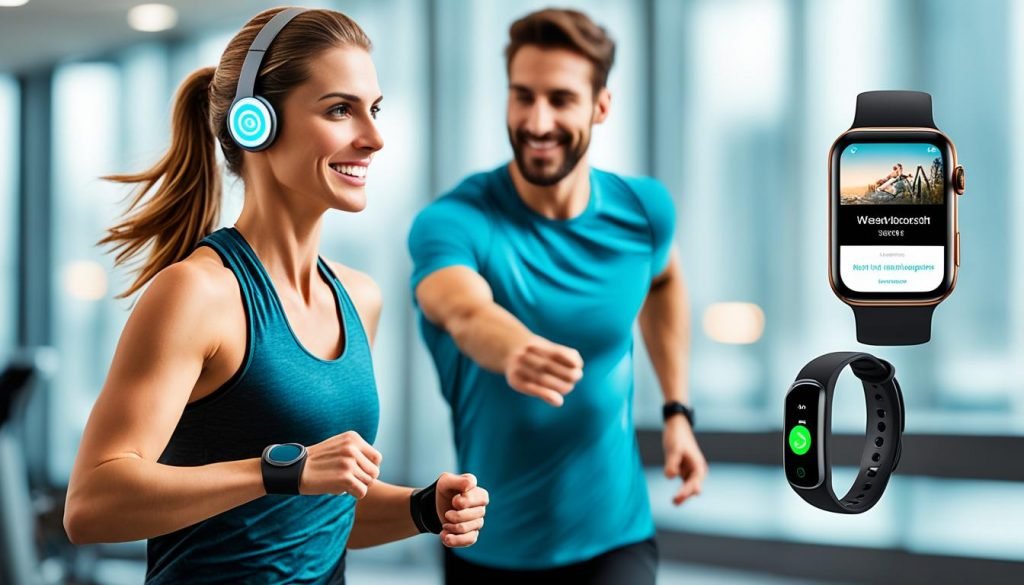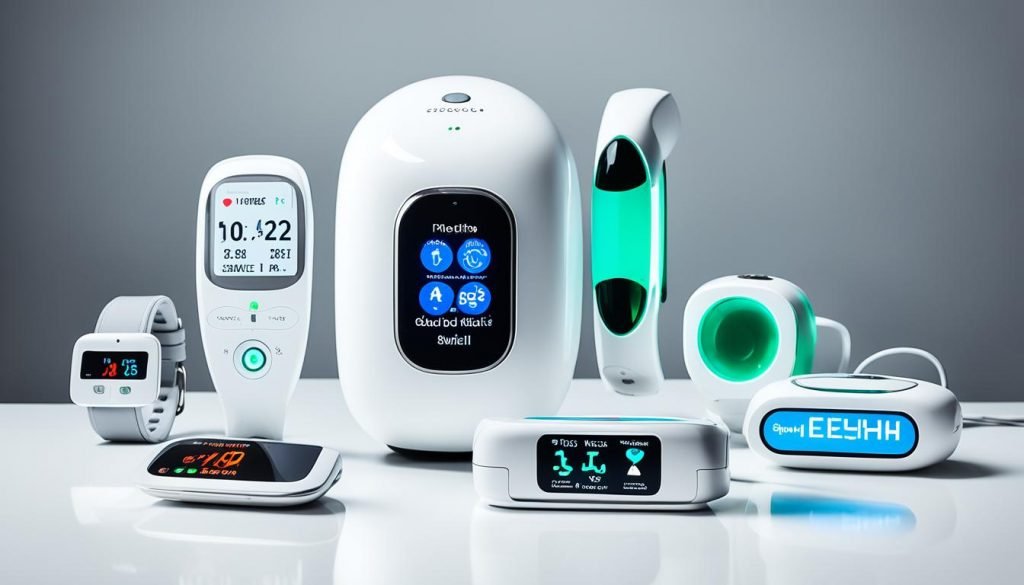Have you ever wondered how wearable technology is transforming the way we live and interact with our devices? From fitness trackers and smartwatches to health monitoring devices and other wearable gadgets, wearable technology has become an integral part of our everyday lives. But how exactly is it revolutionizing the way we live? Let’s explore the future of wearable technology and discover the innovative ways it is integrating into our everyday routines.

Key Takeaways:
- Wearable technology is constantly evolving, with new innovations shaping the market.
- The growth of wearable devices, such as fitness trackers and smartwatches, is driving the wearable technology market.
- Fitness trackers offer valuable health and wellness monitoring features, motivating users to achieve their fitness goals.
- Smartwatches have become multifunctional gadgets, offering features beyond timekeeping.
- Wearable technology is revolutionizing healthcare through remote patient monitoring and enhanced health monitoring capabilities.
The Growth of Wearable Technology
The wearable technology market has experienced significant growth over the past decade. According to market research, the market size for wearable technology is expected to reach USD XX.X billion by 2031. The increased adoption of wearable devices, such as fitness trackers and smartwatches, has driven this growth.
Some of the key trends in wearable technology include:
- Advancements in health monitoring capabilities
- Integration with smartphones and other devices
- The development of more stylish and customizable wearable gadgets
These trends reflect the evolving consumer demand for wearable devices that not only offer practical functionality but also blend seamlessly with their personal style and preferences. As technology continues to advance, we can expect further innovations in the wearable technology market, catering to an increasingly diverse range of needs and preferences.
With the increasing integration of wearable technology into our daily lives, the possibilities for its future applications are virtually limitless.
Fitness Trackers: Monitoring Health and Wellness
Fitness trackers have taken the world by storm as one of the most popular forms of wearable technology. These innovative devices provide individuals with the ability to monitor their health and wellness on a daily basis, empowering them to achieve their fitness goals and maintain a healthy lifestyle.
One of the key features of fitness trackers is their ability to track a wide range of health metrics. From steps taken and calories burned to heart rate monitoring and sleep patterns, these devices provide users with a comprehensive overview of their overall health and well-being.
By wearing a fitness tracker throughout the day, individuals can gain valuable insights into their activity levels and make informed decisions about their fitness routines. The data collected by these trackers can help users identify areas for improvement, set realistic goals, and stay motivated on their fitness journey.
Moreover, fitness trackers are often integrated with mobile apps and other devices, allowing users to access a complete health monitoring experience. These integrations enable individuals to view their data, track progress, and even participate in challenges or connect with fellow fitness enthusiasts.
“Fitness trackers provide users with valuable insights into their overall health and help motivate them to achieve their fitness goals.”
The Advantages of Fitness Trackers
There are several advantages to using fitness trackers for health and wellness monitoring:
- Goal Setting and Motivation: By setting achievable goals and tracking progress, fitness trackers keep users motivated and accountable.
- Activity Monitoring: With accurate tracking capabilities, these devices give individuals a clear picture of their daily activity levels, helping them make healthier choices.
- Heart Rate Tracking: Fitness trackers provide real-time data on heart rate, allowing users to optimize their workouts and ensure they are in their target heart rate zone.
- Sleep Tracking: Sleep plays a crucial role in overall health and well-being. Fitness trackers provide insights into sleep patterns, helping users understand their sleep quality and make improvements if necessary.
An Example of Fitness Tracker Data
| Date | Steps | Calories Burned | Heart Rate (bpm) | Sleep Duration (hours) |
|---|---|---|---|---|
| 2022-07-01 | 10,000 | 350 | 75 | 7.5 |
| 2022-07-02 | 5,000 | 200 | 80 | 6.8 |
| 2022-07-03 | 15,000 | 600 | 85 | 8.2 |
The table above shows an example of fitness tracker data over a three-day period. This data provides a snapshot of the user’s activity levels, calories burned, heart rate, and sleep duration. By analyzing this information, individuals can gain insights into their daily habits and make adjustments to improve their overall health and wellness.
Smartwatches: More Than Just Timekeeping
Smartwatches have undergone a remarkable transformation from simple timekeeping devices to multifunctional gadgets. These wearable tech innovations offer a plethora of features that go beyond just telling time. From fitness tracking to notification alerts, GPS navigation to music control, and even contactless payment capabilities, smartwatches have become an indispensable accessory for tech-savvy individuals who want to stay connected on the go.
One of the most notable aspects of smartwatches is their ability to track fitness and health-related metrics. These devices equipped with sensors can monitor activities such as steps taken, calories burned, heart rate, sleep patterns, and more. With real-time data and personalized insights, smartwatches empower users to optimize their health and fitness goals.
In addition to health monitoring, smartwatches offer a seamless integration with smartphones and other smart devices. With the ability to receive notification alerts for calls, messages, and emails directly on the wrist, users can stay connected without constantly reaching for their phones. Moreover, smartwatches provide convenient access to various smartphone functionalities, including music control, navigating through GPS, and even making contactless payments using popular mobile payment platforms.
The stylish and sleek designs of smartwatches allow them to double as fashionable accessories. With customizable watch faces and interchangeable straps, users can personalize their smartwatch to suit their style and preferences. Whether in a formal or casual setting, smartwatches effortlessly blend technology with fashion, making a statement on the wearer’s wrist.
“Smartwatches have transformed the way we interact with technology. They have empowered users to access information, stay connected, and track their health in a stylish and convenient manner.”
Key Features of Smartwatches:
- Fitness tracking capabilities
- Real-time notification alerts
- Integration with smartphones and smart devices
- GPS navigation
- Music control
- Contactless payment capabilities
With continuous advancements in the field of wearable technology, smartwatches are expected to evolve further and offer even more innovative features in the future. The integration of artificial intelligence, improved battery life, and advancements in sensor technologies will drive the next wave of smartwatch innovations, enhancing their functionality and usability.
Health Monitoring: Revolutionizing Healthcare
Wearable technology is transforming the healthcare industry by introducing innovative health monitoring devices that enable remote patient monitoring and enhance healthcare delivery. These wearable devices, such as smartwatches and specialized wearables, empower individuals to track their vital signs, manage chronic conditions, and receive personalized health recommendations.
With the advancement of wearable technology in healthcare, patients can now conveniently monitor their health in real-time, regardless of their location. Remote patient monitoring allows healthcare providers to remotely monitor patients’ health status, enabling timely interventions and reducing the need for frequent in-person visits. This not only improves patient outcomes but also makes healthcare more efficient and cost-effective.
Smartwatches, for example, offer a range of health monitoring capabilities, including tracking heart rate, blood pressure, sleep patterns, and physical activity. These devices provide users with valuable insights into their overall health and enable them to make more informed decisions about their well-being. With the integration of AI-powered algorithms, wearable devices can analyze data collected over time to provide personalized health recommendations and identify potential health issues before they escalate.
Benefits of Wearable Technology in Healthcare:
- Improved patient engagement and empowerment
- Real-time health monitoring and data tracking
- Enhanced treatment adherence and medication management
- Early detection of health issues and proactive interventions
- Increase in patient-provider communication and collaboration
Wearable technology is transforming healthcare by empowering individuals to take charge of their health and enabling healthcare providers to remotely monitor and manage patients’ well-being. The seamless integration of wearable devices into healthcare systems is revolutionizing the way we approach healthcare delivery.
Furthermore, wearable technology facilitates the seamless integration of health data into electronic health records (EHRs) and telehealth platforms, allowing healthcare providers to access comprehensive patient information accurately and efficiently. This integration streamlines the decision-making process and enables personalized treatment plans that are tailored to each individual’s needs.
As the adoption of wearable technology in healthcare continues to grow, we can expect to see further advancements in health monitoring capabilities. The future holds the promise of wearable devices with improved accuracy, longer battery life, and advanced sensors to track an even wider range of health parameters.

| Benefits of Wearable Technology in Healthcare | Examples of Health Monitoring Devices |
|---|---|
| Improved patient engagement and empowerment | Smartwatches with personalized health recommendations |
| Real-time health monitoring and data tracking | Fitness trackers measuring steps, heart rate, and sleep patterns |
| Enhanced treatment adherence and medication management | Smart pillboxes with reminders and medication tracking |
| Early detection of health issues and proactive interventions | Wearable ECG monitors for detecting abnormal heart rhythms |
| Increase in patient-provider communication and collaboration | Wearable devices with telehealth capabilities |
Everyday Convenience: Wearable Gadgets for Daily Use
In addition to fitness and health monitoring, wearable technology offers everyday convenience through a variety of wearable gadgets. These gadgets enhance our lives by providing hands-free functionality, personalized experiences, and improved productivity in various aspects of our daily routines.
Smart Glasses
Smart glasses are one of the most popular wearable gadgets, featuring a display that is integrated into the eyewear. These glasses offer augmented reality experiences, providing users with information directly in their field of vision. From displaying navigation instructions while walking to showing real-time translations during travel, smart glasses bring a new level of convenience and functionality to our everyday lives.
Smart Clothing
Smart clothing is another innovative wearable technology that combines fashion with functionality. These garments are embedded with sensors and other electronics, allowing them to track metrics such as heart rate, body temperature, and even posture. With the ability to connect to smartphones and other devices, smart clothing provides users with real-time data and insights for improved health and wellness.
Wearable Cameras
Wearable cameras have gained popularity among adventure enthusiasts, vloggers, and everyday users alike. These compact cameras can be attached to clothing or accessories, allowing users to capture hands-free photos and videos of their experiences. Whether it’s documenting a hike, recording a workout session, or capturing special moments with loved ones, wearable cameras offer a convenient way to capture life’s memories.
Smart Jewelry
Smart jewelry combines fashion and technology, offering users a stylish way to stay connected and informed. From smartwatches disguised as elegant bracelets to smart rings that display notifications and track physical activity, these accessories provide convenient access to information and enhance connectivity without compromising on style.
Overall, wearable gadgets provide us with the convenience of having essential features and functions right at our fingertips. They seamlessly integrate into our daily routines, making tasks more efficient and enjoyable. Whether it’s staying connected, tracking our health, or documenting our adventures, wearable tech accessories enhance our lives in ways we never thought possible.
| Wearable Gadget | Key Features |
|---|---|
| Smart Glasses | Augmented reality experiences, hands-free functionality |
| Smart Clothing | Health and wellness tracking, real-time data insights |
| Wearable Cameras | Hands-free photo and video capture |
| Smart Jewelry | Stylish connectivity and information access |
Innovations and Trends in Wearable Technology
The field of wearable technology is constantly evolving, with new innovations and trends emerging regularly. These advancements are pushing the boundaries of what wearable technology can achieve and opening up new possibilities for the future.
Integration of Artificial Intelligence and Machine Learning
One of the latest trends in wearable technology is the integration of artificial intelligence (AI) and machine learning capabilities into wearable devices. This integration allows wearables to analyze and interpret data in real-time, providing users with personalized insights and recommendations. AI-powered wearables can learn from user behavior and adapt their functionality accordingly, making them more intuitive and tailored to individual needs.
Development of Flexible and Stretchable Wearables
Another exciting trend in wearable technology is the development of flexible and stretchable wearables. These innovative devices are made from materials that can bend, twist, and stretch without compromising functionality. Flexible wearables offer a more comfortable and ergonomic fit, allowing users to wear them for extended periods with ease. These wearables can be seamlessly integrated into clothing, accessories, and even fabrics, making them more discreet and convenient.
New Sensor Technologies for Accurate Health Monitoring
The quest for more accurate health monitoring has driven the exploration of new sensor technologies in wearable devices. These sensors go beyond traditional heart rate and activity tracking to measure and monitor a wide range of health parameters. For example, biosensors can detect glucose levels in real-time, providing valuable information for individuals with diabetes. Other sensor technologies include temperature sensors, sweat sensors, and even emotional sensors that analyze physiological responses to stress or mood changes.
With constant innovations and advancements in wearable technology, the possibilities for improving health monitoring and enhancing overall well-being are endless.
The Future of Wearable Technology
The future of wearable technology holds great promise. As the industry continues to grow and evolve, we can expect even greater integration of AI and machine learning, as well as the development of more flexible and stretchable wearables. The focus on accurate health monitoring will continue, with advancements in sensor technologies that enable more precise and comprehensive data collection. This will empower individuals to take control of their health and make data-driven decisions.
Overall, the innovations and trends in wearable technology are reshaping the way we live and interact with technology. From AI-powered wearables to flexible and stretchable devices, the future looks bright for this rapidly evolving industry.
Challenges and Future Outlook of Wearable Technology
While wearable technology has made significant strides in recent years, it still faces several challenges that need to be addressed. These challenges include concerns over privacy and data security, the need for longer battery life, and the development of more intuitive user interfaces.
One of the main challenges of wearable technology is the privacy and security of user data. As wearable devices collect and store personal information, there is a growing concern about how this data is being used and protected. Manufacturers and developers need to prioritize data security to ensure user privacy and build trust with their customers.
Another challenge is the limited battery life of wearable devices. Many users find themselves constantly charging their devices, which can be inconvenient, especially during busy days or outdoor activities. Improving battery life and efficiency is crucial for enhancing the user experience and allowing wearable devices to be used for longer periods without interruptions.
Additionally, wearable technology needs to focus on developing more intuitive user interfaces. With smaller screens and limited control options, users often find it difficult to navigate and interact with their wearable devices. By improving the user interface design and incorporating more natural forms of interaction, wearable devices can become easier and more enjoyable to use.
Despite these challenges, the future of wearable tech looks promising. As technology continues to advance, these challenges are being addressed, and innovative solutions are being developed. The integration of wearable technology into various industries, such as healthcare, sports, and fashion, will continue to drive innovation and shape the future of wearable tech.
With ongoing advancements, wearable technology has the potential to revolutionize how we live, work, and interact with the world around us. From enabling remote health monitoring to enhancing everyday convenience, wearable tech will continue to evolve and transform various aspects of our lives.
Conclusion
Wearable technology has revolutionized the way we live and interact with our devices. By offering convenience, improved health monitoring, and innovative features, wearables have become an integral part of many people’s lives. As the market for wearable technology continues to grow, new advancements and trends emerge regularly, promising an exciting future for the industry.
With ongoing innovations in technology, wearable tech has the potential to transform various industries and enhance our everyday lives. From fitness trackers and smartwatches to health monitoring devices and other wearable gadgets, the possibilities are endless. Wearable devices are becoming more than just fashion accessories; they are powerful tools that provide valuable insights into our health, help us stay connected, and increase our productivity.
While challenges remain, such as privacy and data security concerns, the wearable technology industry is actively addressing these issues. As technology continues to evolve, we can expect longer battery life, more intuitive user interfaces, and increased integration with other smart devices. By addressing these challenges and focusing on user needs, the future of wearable tech looks promising.
In conclusion, wearable technology has already transformed how we live, work, and play. The market’s continued growth, along with ongoing innovations and the focus on addressing challenges, will shape the future of wearable tech. As we embrace the potential of wearables, we can expect even more exciting developments that will enhance our lives and revolutionize various industries.
FAQ
What is wearable technology?
What are some examples of wearable technology?
How does fitness tracking work?
What features do smartwatches offer?
How is wearable technology used in healthcare?
What are some challenges of wearable technology?
What is the future outlook for wearable technology?
Source Links
- https://www.linkedin.com/pulse/pet-wearable-devices-market-report-npi8f?trk=article-ssr-frontend-pulse_more-articles_related-content-card
- https://www.linkedin.com/pulse/pet-ct-scanners-market-report-2031-puzgf?trk=article-ssr-frontend-pulse_more-articles_related-content-card
- https://www.linkedin.com/pulse/pet-travel-services-market-insights-tsq2f?trk=article-ssr-frontend-pulse_more-articles_related-content-card


